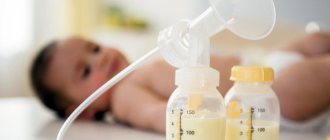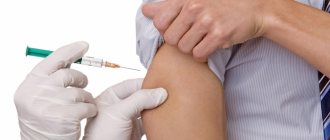Analysis of stool for dysbiosis in children is considered the main method that can determine the immaturity of the gastrointestinal tract, as well as a violation of healthy intestinal microflora. Dysbacteriosis in an infant can be a consequence of many pathologies. Dysbacteriosis does not have a specific clinical picture, so it can occur, accompanied by various symptoms. Many manifestations of this pathology are similar to signs of other diseases of the digestive tract. For this reason, in order to diagnose dysbiosis, it is necessary to undergo appropriate laboratory tests. The correct collection of material for analysis deserves special attention. This process can be difficult for parents, since with dysbiosis the child may experience constipation or difficulty defecating. What do you need to know when collecting biomaterial for analysis?
What does the analysis for dysbacteriosis show?
Dysbacteriosis is an imbalance of intestinal microflora: a condition in which the number of pathogenic and opportunistic bacteria exceeds the number of beneficial ones.
According to the provisions of the regulatory document of the World Health Organization, it is not considered a disease, but many pediatric doctors prescribe tests in the first year of a child’s life to identify dysbiosis and its causes. With this diagnosis, the baby may experience prolonged constipation, diarrhea, abdominal pain, and allergic reactions.
Experts believe that stool analysis for dysbiosis in infants should reflect information about the biocenosis in the intestines. In fact, the analysis only reflects the microbial composition of stool. From it you can judge what the current state of the microflora is, but how normal it is for a particular child cannot be understood from it.
Dysbacteriosis – cause or effect?
It is believed that dysbiosis is always a secondary condition, i.e. it cannot arise on its own. On the other hand, this condition can cause the development, for example, of intestinal infections and hypovitaminosis (vitamin absorption occurs mainly in the intestines).
How to recognize dysbiosis?
An imbalance of intestinal microflora does not cause the development of any characteristic symptoms that can be used to make a diagnosis. But tests for dysbiosis in children should be done if there is a suspicion of dysbiosis - namely, with the following symptoms:
- diarrhea – frequent stools may be thin, runny or watery,
- constipation (stools are rare and hard),
- flatulence,
- stomach ache,
- anxiety.
If a child has one or more symptoms, a stool sample should be collected. It is important to remember that, unlike intestinal infections, with dysbiosis there is no increase in body temperature, babies feel good and gain weight.
A frequently asked question should be answered: “How much feces in infants can be considered diarrhea?” Frequent bowel movements in a newborn are normal. The number of times you put your baby to your breast is the number of times you will need to change the diaper. Diarrhea can be considered too loose stool, especially if it contains green inclusions.
Symptoms and norms
When clostridia, lactose-negative enterobacteria, Klebsiella, Candida fungus, Staphylococcus aureus and other pathogens begin to predominate in the intestine over beneficial microorganisms, dysbiosis develops. Increased proliferation of microbes in a baby is accompanied by the following symptoms:
- regurgitation;
- diarrhea;
- blood, mucus in stool;
- constipation;
- diseases of the digestive system;
- increased accumulation of gases in the stomach (bloating);
- allergic reactions;
- abdominal pain;
- poor appetite;
- there are traces of white coating on the tongue;
- bad breath;
- the baby is often sick.
They will prescribe a dysbiosis test for the baby during or after antibiotic treatment. These medications can cope not only with pathogenic bacteria that have affected the body (clostridium, klebsiella, Staphylococcus aureus, etc.), but also kill beneficial microflora.
Dysbacteriosis can only be detected through stool analysis. Thanks to it, it is possible to determine which pathogenic bacteria have exceeded the norm, which will make it possible to prescribe the correct therapy. This is explained by the fact that to destroy the Candida fungus, different methods are needed than when activating clostridia, Staphylococcus aureus, Klebsiella or other pathogen.
Normally, the number of beneficial and harmful bacteria in the intestines of a baby should fluctuate within the following limits:
| Bacteria | Normal for infants | Children 1 year | After a year | ||
| Form of feeding | |||||
| Chest | Mixed | Artificial | |||
| Bifidobacteria | 10 7 -10 11 | 10 6 -10 9 | 10 6 -10 8 | 10 10 -10 11 | 10 9 -10 10 |
| Lactobacilli | 10 5 | 10 4 -10 6 | 10 4 -10 6 | 10 6 -10 7 | 10 7 -10 8 |
| E. coli | 10 5 -10 8 | 10 6 -10 9 | 10 7 -10 9 | 10 7 -10 8 | 10 7 -10 8 |
| Lactose-negative enterobacteriaceae | 10 3 -10 6 | 10 5 -10 7 | 10 5 -10 7 | up to 10 4 | until 10 7 |
| Enterococci | — | 10 5 -10 9 | 10 6 -10 9 | 10 6 -10 7 | 10 7 -10 8 |
| Staphylococcus | 10 2 -10 4 | 10 3 -105 | 10 3 -10 6 | up to 10 5 | up to 10 4 |
| Clostridia | 10 1 -10 3 | 10 2 -10 4 | 10 3 -10 6 | up to 10 5 | up to 10 5 |
| Candida | 10 2 -10 4 | 10 1 -10 3 | 10 2 -10 4 | up to 10 3 | up to 10 4 |
It is not worth treating a child on your own, having only a transcript of the results in hand: a doctor must prescribe treatment. Each of these pathogens (clostridia, lactose-negative enterobacteria, Klebsiella, Escherichia) requires an individual approach to treatment. Otherwise, you can cause serious harm to the baby and provoke the development of chronic diseases that he will not get rid of even as an adult.
Causes of dysbiosis and indications for examination
There are many reasons for the occurrence of this pathological condition. These include: • pathological pregnancy, provoking immaturity and impaired immunological reactivity of the gastrointestinal tract in the newborn; • taking various medications by a pregnant woman at different stages of gestation; • unfavorable environment; • malnutrition of a nursing mother; • respiratory and intestinal infections that negatively affect the intestinal microflora; • use of antibiotics, their uncontrolled use, self-medication in infants; • early transfer to artificial feeding; • carriage of staphylococcus or development of mastitis in the mother; • the presence of concomitant pathologies in the baby (prematurity, rickets, anemia, diathesis), which contribute to a decrease in intestinal immunity, impaired peristalsis and the release of enzymes.
The main indications for testing for dysbacteriosis are: 1. Constant stool retention, alternating constipation and diarrhea. 2. Frequent intestinal colic 1.5 - 2 hours after feeding, which is caused by the accumulation of gases in the intestines. 3. Rumbling and “transfusion” in the tummy, especially during breastfeeding or when formula enters the stomach (this is due to spasms of the stomach and intestines when the stomach is full, the inability of food to enter the intestines due to the accumulation of gases in the upper intestines). 4. Regurgitation. 5. Changes in the characteristics of feces: • consistency is often liquid, watery); • smell (putrid or sour); • Green colour); • presence of impurities (large amounts of mucus, sometimes blood). 6. Suspicion of the likelihood of developing intestinal infections, viral infections with intestinal syndrome, complicated by the addition of pathogenic microbial or fungal flora. 7. Possibility of inflammatory diseases of the digestive system. 8. Frequent colds, indicating a significant weakening of the immune system. A stool test for dysbiosis is performed on newborn children at increased risk of developing infectious complications or in the presence of complex background pathologies (extremely premature babies, babies with anemia, malnutrition or small weight gain, rickets, lymphatic-hypoplastic diathesis, allergic reactions or skin rashes of unknown origin).
Causes of dysbacteriosis
The most common cause of dysbiosis is considered to be immaturity of the gastrointestinal tract. While the baby is in the mother's womb, its intestines are sterile. The first microorganisms enter it during childbirth, from the mother.
Dysbacteriosis in a child can also appear due to:
- late start of breastfeeding or lack thereof. Mother's milk contains an optimal range of nutrients and is a natural source of bifidobacteria. If a child eats breast milk from the very first day, then by the end of the first week an almost complete complex of necessary bacteria is formed in the intestines;
- use of antibiotics. The biggest risk associated with taking antibiotics is the loss of beneficial microflora. If a nursing mother took antibiotics, the process of deterioration of digestion will also be observed in the baby;
- early introduction of complementary foods. It is not recommended to introduce any complementary foods before six months - the baby’s body is not yet adapted to digest solid food;
- food allergies.
Stool collection
The most well-known method of collecting feces from infants is taking it from the diaper. Pediatricians recommend using a disposable gauze diaper for this purpose. After your baby poops, carefully collect the material from the surface of the diaper. You can use a potty to collect feces if the baby has already been placed on it. After six months, children become aware of an impending bowel movement, and an attentive adult can catch the moment. Rinse the pot thoroughly and pour boiling water over it. Collect hard or soft feces using a spoon attached to a sterile container. You can also use another item, say, a disposable plastic spoon. It is recommended to collect different shares: from the center, from the top and from the bottom. It will be enough to collect stool in volume equal to an incomplete teaspoon. Collecting loose stool is much more difficult. For this purpose, medical oilcloth is used. Spread it under the child. A pediatric urinal can also be used to collect liquid feces. It is sold in pharmacies. This is a small plastic sterile bag. It has a hole for collecting vision and an adhesive tape, which is used to attach the urine bag to the baby’s body. When your baby poops, pour the collected mixture into a container.
Recommendations for parents
Parents of newborns should be especially attentive to the health of their children. To prevent the development of dysbacteriosis, it is necessary to monitor the baby’s hygiene, proper and timely complementary feeding, and a varied diet.
Breastfeeding plays an important role in the formation of proper microflora. If there are no problems with lactation, there is no need to stop feeding.
During treatment with antibiotics, the baby must take probiotics. What kind of medicine to choose for your child needs to be decided with the attending physician.
Decoding the analysis in children under one year old
All microorganisms in the analysis form are divided into:
- obligate - permanently inhabiting the body, playing an important role in metabolic processes and protection against infectious diseases;
- facultative - non-permanent residents of the body, which are either conditionally pathogenic (lead to diseases when immunity is reduced) or saprophytes (consume decaying organic substances);
- transient - free-living microorganisms that enter the body from the external environment. They can be both saprophytes and pathogens.
Let us briefly describe the main representatives of the above groups of bacteria.
Bifidobacteria
- Promote the breakdown of fats, carbohydrates, proteins that enter the bloodstream through the intestinal wall.
- Produce organic acids.
- Prevents the proliferation of pathogenic flora in the intestines.
- Promotes the absorption of nutritional elements of food.
- Optimize intestinal motility.
- Activate immunoglobulins and lymphatic elements (provide local immunity).
- Neutralizes toxins and waste.
A lack of bifidobacteria leads to flatulence, diarrhea, and frequent diarrhea.
Lactobacilli
- They convert lactose into lactic acid, which promotes better digestion of food.
- Improves digestion.
- Stimulates metabolic processes.
- They fight pathogenic microflora (especially Helicobacter Pylori strains).
- Some enzymes are activated.
- Participate in the synthesis of vitamins.
If there is a lack of lactobacilli, a child experiences frequent colds, poor digestion of milk, allergic reactions, and constipation.
Video from the Union of Pediatricians of Russia. Dysbacteriosis (dysbiosis).
Bacteroides
They occupy approximately half of the entire intestinal microflora. When maintaining a normal amount, bacteroids perform a number of useful functions - they participate in the utilization of proteins, the breakdown of fats, the fermentation of carbohydrates, and the biotransformation of bile acids. If the levels are exceeded, bacteroids lead to infectious and septic complications and contribute to the destruction of beneficial E. coli (in the fight for oxygen).
Eubacteria
They are more common in formula-fed children and are practically absent in children fed breast milk. Most typical for adults. Their role is not clear enough, but it is known that they are involved in some metabolic processes.
Fusobacteria
More often observed in the intestinal microflora of adults. Some species are sown during purulent-inflammatory processes. Little studied.
Opportunistic bacteria and fungi do not cause intestinal problems in a healthy child until the immune system is weakened or the condition of the intestinal mucosa is disrupted. An increase in the level of opportunistic organisms is also observed against the background of a decrease in indicators of lactobacilli and bifidobacteria. At the same time, the baby experiences flatulence, diarrhea, inflammation of the intestinal mucosa, and increased fermentation processes.
Escherichia (opportunistic Escherichia coli)
- Suppress the growth of pathogenic microorganisms, in particular Shigella, Salmonella and putrefactive microbes.
- Promote the synthesis of folic and nicotinic acid, vitamins K and B.
- Provide local immunity.
- They take part in the breakdown of high molecular weight carbohydrates using enzymes.
- Participate in water-salt and lipid metabolism.
- Helps improve intestinal motility.
If the number of these bacteria is reduced, this indicates the presence of a helminthic infection. Typically, this disorder manifests itself in the form of vomiting, flatulence, rumbling in the stomach, and diarrhea. In addition to the number of Escherichia, the level of Escherichia coli with reduced enzymatic activity is determined.
Veillonella
Found in less than half of examined infants. In the process of vital activity, gaseous products are released and, when excessively multiplied in the intestines, cause dyspeptic disorders.
Peptostreptococci
Just like veillonella, they are rarely found in breastfed children. If they find themselves in unusual living conditions, they can cause various infections. In deep abscesses, they often occupy the second place among anaerobic bacteria in terms of occurrence in pathological material.
Clostridia
Participate in the metabolism of fatty acids and suppression of the activity of pathogenic species of clostridia. Some species, when breaking down proteins, can form toxic products. Decreased immunity and excess meat food can lead to the growth of these bacteria.
Enterococci
Enterococci are the most common representatives of streptococci in the intestines. In the intestinal lumen they are able to ferment carbohydrates into lactic acid, thereby maintaining optimal acidity for the proliferation of beneficial microflora.
Staphylococcus
A large group of microorganisms that enter the intestines from the first days of a child’s life. The most numerous of them is Staphylococcus epidermidis. Increased activity of Staphylococcus aureus causes the appearance of infectious diseases.
Analysis collection rules
The rules for collecting stool for dysbiosis in infants include several important points.
1) 72 hours before the examination you should not:
- introduce new foods into the baby’s diet;
- give any medications, including prebiotics, sorbents, laxatives, etc.;
- give enemas or use suppositories.
Before the procedure, the child must empty the bladder so that urine does not mix with stool when a bowel movement occurs.
2) feces for dysbacteriosis in infants should be in the morning as much as possible.
3) the container must be delivered to the laboratory where the research will be carried out no later than 2-3 hours after stool collection. If necessary, the material for analysis can be placed in the refrigerator for a short time. You can't freeze stool! It is unacceptable to provide the laboratory with a jar of material for analysis that has been in the refrigerator all night, or obtained using rectal suppositories - to avoid the ingress of foreign impurities.
4) a stool test for dysbacteriosis in an infant is usually done within 1 week. During this period, data is gradually collected on the state of the baby’s intestinal microflora. Employees of the laboratory where the research is being conducted place feces in a specially created nutrient medium. All organisms contained in feces will grow in this environment. They will then be examined using a microscope.
Preparation and procedure for conducting this survey
Proper preparation and collection of material for research has a huge impact on the maximum accuracy of the results. Therefore, parents should know what points they need to pay attention to: • before the examination, for 3-4 days you cannot introduce new foods into the baby’s diet, give vitamins and various medications, especially antibiotics and sorbents; • before collecting feces, there is no need to stimulate the passage of feces by any means; taking any laxatives and enemas is contraindicated - the child must poop on his own; • before defecation, you need to wash the baby with warm water; • stool should be collected in the morning and delivered to the laboratory within an hour, preferably warm; • to collect the material you need to use a special sterile container with a spoon (this container can be purchased at a pharmacy or asked for in the bacteriological laboratory where the analysis will be carried out); • it is better to collect feces from a pre-prepared clean, dry and disinfected potty, or from a specially prepared diaper from a diaper (it is highly undesirable to collect feces from a diaper - the gel base actively adsorbs loose stool, and the results will be incorrect; • the study requires from 4 to 9 grams of feces.
How to collect stool for analysis
So, the doctor ordered a test for dysbiosis in the baby. How to collect material for analysis?
Experts do not recommend using a diaper to collect feces. If the toilet is performed at a certain time in the morning, it is necessary to place the child on a clean oilcloth, and then carefully collect what happened from it.
If you have problems with bowel movements, you can help your baby by bending his legs towards the navel or laying him on his tummy. You can also use a rubber gas tube for stimulation, lubricating the tip with Vaseline. It needs to be inserted into the anus - shallowly - and rotated slightly. A few minutes after this procedure everything will happen. Feces need to be collected with a spoon, which comes with the container for testing.
You can also help your baby by giving him a tummy massage. Place your palm on the belly near the navel and gently massage your baby's tummy in a clockwise direction. Periodically press the baby's bent knees toward his stomach to speed up the process.
On the container with the received material, it is necessary to indicate the surname, first name and age of the child, as well as the time of stool collection.
In older age groups
- With long-term antibiotic therapy;
- unfavorable environmental situation;
- the use of certain pharmacological groups of drugs, for example, hormones or cytostatics;
- under stress;
- the use of chemotherapy for cancer patients;
- a decrease in the immune status of the body as a whole.
To establish an accurate diagnosis, it is necessary to be tested for dysbacteriosis. It will help establish the qualitative and quantitative composition of microorganisms in the gastrointestinal tract (GIT).
Types of bacteria in the results of stool analysis for dysbacteriosis
Pathogenic and opportunistic bacteria
Pathogenic bacteria are bacteria that parasitize other organisms and can cause infection. Under favorable conditions they reproduce very quickly. Pathogenic bacteria are extremely harmful bacteria that are the causative agents of infectious diseases: typhoid fever, salmonellosis, dysentery, etc. Normally, these bacteria should not exist at all.
Opportunistic bacteria are bacteria that, under normal conditions, do not cause harm to human health. However, if health deteriorates and immunity decreases, they become pathogenic, can cause inflammation and lead to the development of certain diseases.
Gram-positive and gram-negative bacteria
They are named after the Danish scientist Gram, who first introduced these concepts into use. When staining microorganisms with a special dye—gentian violet—Gram noticed that one group of bacteria (Gram-positive) was stainable, while the other (Gram-negative) was not. The reason for this is the thickness of the cell wall.
Gram-positive bacteria produce spores and exotoxins. They pose a danger to the body. But their shell allows antibacterial drugs to pass through.
Gram-negative bacteria can also cause serious illness. They do not form spores, but under certain conditions their shell, when destroyed, releases endotoxins, which can lead to various serious diseases. Unlike gram-positive bacteria, their shell is insensitive to antibiotics.
The correct ratio of gram-positive and gram-negative bacteria maintains normal internal microflora in the body.
Bifidobacteria
Bifidobacteria are gram-positive anaerobic bacteria that are shaped like curved rods. They make up the bulk of the intestinal microflora. To date, more than 30 species of bifidobacteria are known. They inhabit the large intestine. In the body, bifidobacteria perform the following functions:
— ensure normal functioning of the intestines by producing organic acids;
- control the proliferation of bacteria and viruses in the body;
- fight allergens;
— ensure the absorption of microelements, break down proteins, fats and carbohydrates;
— stimulate intestinal motility, ensure the processes of protein and fat metabolism;
- support immunity.
Lactobacilli
Lactobacilli are also gram-positive bacteria. They are located in many parts of the gastrointestinal tract, including the oral mucosa. Their main function is to maintain a normal acid-base balance in the body: lactobacilli convert lactose that enters the body with food into lactic acid. Lactobacilli also actively fight harmful microorganisms and create optimal conditions for successful digestion.
Eschejeria
Eschericheria (non-pathogenic Escherichia coli) is a type of gram-negative rod-shaped bacteria that is part of the normal microflora of the gastrointestinal tract. The main functions are to ensure digestion, activate the immune system, destroy pathogenic bacteria, produce vitamins B1, B1, B3, B5, B6. A decrease in the number of Eschecheria may indicate the presence of worms.
As a percentage of other representatives of the intestinal microflora, Escherichia coli does not exceed 1%.
Bacteroides
Bacteroides is a genus of gram-negative anaerobic rod-shaped bacteria. They belong to opportunistic bacteria. They are representatives of normal intestinal microflora. Their main function is the breakdown of fats. A child who was recently born does not have them in the body; they appear after six months.
Enterococci in stool analysis for dysbacteriosis
Enterococci are a genus of gram-positive bacteria of the Enterococcus family (Enterococccaceae), the most important representative of the body's microflora. They have a round or slightly oval shape and multiply quickly at temperatures of 35-37 degrees. Enterococci exist even with a small amount of oxygen.
Enterococci are opportunistic bacteria; excess levels of these bacteria can cause inflammation.
When performing an analysis for dysbacteriosis, among other bacteria, the number of enterococci is also examined. Enterococci in an analysis for dysbacteriosis in an infant should not exceed the norm - from 105 to 107 per 1 gram of feces.
The main therapy for fecal enterococcus is bacteriophages. They are less harmful than antibiotics in terms of the number of side effects, and they are often prescribed to children when an excess of the permissible limit is detected.
Microbes of the genus Protea
Microbes of the genus Protea are a genus of gram-negative bacteria, facultative anaerobes. The average size of an individual is 0.6 * 2.5 microns. They belong to opportunistic bacteria. They can provoke the development of many serious diseases requiring hospitalization.
Klebsiella
Also included in the list of opportunistic microorganisms. If the body is weakened, it can lead to pneumonia, urinary tract infections, and diarrhea.
What does Klebsiella lead to? Read personal experience here
Staphylococcus aureus
Staphylococcus aureus is an opportunistic microorganism. Refers to pathogens that can cause sore throats, folliculitis and other acute pathologies.
Staphylococcus epidermidis
Also refers to opportunistic bacteria. Lives in the surface layer of the skin - the epidermis. Can cause cystitis, urethritis, kidney pathology, tonsillitis, laryngitis, damage to the reproductive system and respiratory tract.
Enterobacter
It is an opportunistic bacteria that lives in the large intestine. Can cause nosocomial infections, blood poisoning, damage to the respiratory and genitourinary systems.
Pseudomonas aeruginosa
Gram-negative bacterium, opportunistic organism. One of the most common pathogens of nosocomial infections. Retains viability even in disinfectant solutions. It can affect various organs - skin, eyes, ears, gastrointestinal tract, urinary tract.
Clostridia
Gram-positive bacteria. They live in the mycophore of the gastrointestinal tract, on the skin, and in the oral cavity. May cause tetanus, gas gangrene, colitis.
Interpretation of results: norm and pathology
Laboratory diagnosis of analysis for dysbacteriosis consists of bacteriological and biochemical examination of feces. At the same time, the number of lacto- and bifidobacteria, normal E. coli, their decrease or increase, is determined, the presence of altered strains, the number of cocci, fungi and clostridia are determined. But in order to assess the state of the digestive tract in an infant, it is necessary to know the normal indicators of intestinal biogeocenosis:
| Indicators | Normal amount in 1 gram |
| Lactobacilli | 107 |
| Bifidobacteria | 1011 |
| Enterococci | 105 – 106 |
| Complete E. coli | 106 — 107 |
| Lactase-negative Escherichia coli | No |
| Hemolyzing Escherichia coli | No |
| Bacteroides | 108 |
| Saprophytic staphylococcus | 0 to 103 |
| Pathogenic (aureus) Staphylococcus | No |
| Clostridia | 103 |
| Pathogenic enterobacteria | No |
| Fungi of the genus Candida and yeast-like fungi | up to 103 |
| Streptococci | up to 103 |
Deviation from age-related indicators of the qualitative and quantitative composition of normal microflora and the presence of pathogenic microorganisms is intestinal dysbiosis.
There are several degrees of severity and nature of the disease:
| Degree | Nature of changes | Disease phase | Symptoms |
| 1 | Reduction of bifidobacteria and lactobacilli by 3-4 orders of magnitude, the presence of opportunistic flora up to 105 (Proteus, Klebsiella, cocci) | Latent | The beginning of manifestations of intestinal dysfunction - flatulence, stool retention, alternating constipation and diarrhea, periodic restlessness after feeding |
| 2 | Reduction of bifidobacteria and lactobacilli by 3-4 orders of magnitude, the presence of opportunistic flora up to 105 (Proteus, Klebsiella, cocci) | Launcher | The beginning of manifestations of intestinal dysfunction - flatulence, stool retention, alternating constipation and diarrhea, periodic restlessness after feeding |
| 3 | Reduction of bifidobacteria and lactobacilli to 105 and below. Reproduction of opportunistic microflora and the appearance of pathogenic microorganisms (Staphylococcus aureus, hemolyzing Escherichia coli, fungi) | Aggression of aerobic microflora | Moderately pronounced signs of dysbacteriosis with a gradual worsening of symptoms |
| 4 | A marked decrease in bifidobacteria and lactobacilli, profound changes in various microflora with a predominance of pathogenic microorganisms | Associative dysbiosis | Severe clinical symptoms - intoxication, weight loss, diarrhea, regurgitation, bloating, vomiting, sleep disturbances |
Only the attending physician can correctly decipher the analysis; based on this, treatment will be prescribed. pediatrician Sazonova Olga Ivanovna
Every mother worries about her children, especially at the beginning of their life journey. Not in vain. When leaving the mother's womb, a newborn baby faces a completely new and unfamiliar world. Including the world of bacteria, viruses and other microorganisms.
When a child is born, he encounters bacteria for the first time, so it is not surprising that the balance of microflora in children under one year of age is most often disturbed. An intestinal disease associated with such a deviation is called dysbiosis. There is no need to be scared if a baby has been prescribed to have stool tested for dysbacteriosis, but it is worth understanding the specifics of the process.
Features of therapy
Treatment largely depends on which microorganisms have deviated from the norm, whether there is mucus, blood and other particles in the stool that should not be there. The doctor, studying the results, makes a diagnosis no earlier than he analyzes all the indicators.
If the transcript shows a decrease in the amount of E. coli, this may indicate the presence of worms in the intestines. Sometimes the cause may be a decrease in enzymatic activity, which is why this bacterium does not bring any benefit (although it does not harm). Despite all the benefits of E. coli, its number should not exceed the norm. If this happens, it means that dysbiosis is developing in the body.
As for hemolytic E. coli, in young children they should be completely absent. These pathogens produce toxins that negatively affect the nervous system and intestines, and can also cause various intestinal diseases and allergies.
Deficiency of bifidobacteria and bacteroides leads to long-term intestinal disorders in both children and adults. These bacteria appear in the baby on the tenth day of life. At the same time, children born through cesarean section have significantly fewer of them than babies born naturally.
Lactose-negative enterobacteria in children and adults should not exceed the norm. If the analysis shows their increased proliferation, this can explain the baby’s heartburn, regurgitation, belching, and increased gas formation. Enterococci normally do not harm the body and are even beneficial. But if their number is higher than normal, they will cause the development of infectious diseases of the pelvic organs and urinary tract.
While non-pathogenic staphylococci do not particularly harm the body (within normal limits), the presence of Staphylococcus aureus is dangerous for children. It causes diarrhea, vomiting, abdominal pain, high fever in the baby, mucus and blood are present in the stool. Therefore, Staphylococcus aureus should be absent in the feces of infants . If Staphylococcus aureus is present in the body, then its effect depends on beneficial bacteria . If their number is normal, the body is not afraid of Staphylococcus aureus and the baby does not need treatment. In severe cases, hospitalization is required.
When the doctor prescribes treatment, his instructions must be followed. To destroy fungus, clostridia, Klebsiella, lactose-negative enterobacteria, Staphylococcus aureus, normalize the digestive system, and get rid of mucus in the feces, special medications designed for small children are needed.
During treatment, special attention should be paid to the nutrition of children, since in many cases it is an incorrectly selected diet that causes the growth of clostridia, enterobacteria, Klebsiella and other pathogens. The diet must be agreed with your doctor. If the baby is breastfed, the mother must follow the diet.
When testing for dysbacteriosis in a child’s body, a tendency is immediately revealed that confirms the immaturity of the organs of the digestive system. At the same time, this type of analysis confirms the existing imbalance in the intestinal microflora. Most often, with dysbacteriosis in infants or newborns, there is a risk of having any diseases, as a result of which a malfunction occurred in the body. In most cases, dysbiosis does not have pronounced symptoms and is usually similar to any other disease of the digestive tract. In this regard, it becomes quite difficult to determine and identify dysbiosis in the child’s body. Therefore, submitting stool for analysis is one of the reliable and accurate laboratory methods that can confirm this diagnosis.
Adaptation period
In the first months of its existence, the baby goes through a difficult period of adaptation to the world around it. Many vital processes occurring in the body do not proceed in the same way as in mature adults. The respiratory, gastrointestinal systems, heat exchange systems, and other vitally important functions of the body are in the stage of formation and improvement. This is how nature intended it, so that the child could naturally, through a special mode of functioning of the body, smoothly and easily adapt to the outside world. Consequently, a huge part of the phenomena that can cause anxiety among parents is not pathology. Rather, this is the norm for the positive development of the baby.
Decoding the analysis for dysbacteriosis
Below is a breakdown of the test for dysbacteriosis in infants . As mentioned earlier, the results of the test for dysbiosis may vary from child to child. The following indicators are considered the recognized norm for infants:
- Bifidobacterium spp. (bifidobacteria) - from 109 to 10 12. A decrease in numbers indicates the presence of dysbacteriosis.
- Lactobacillius spp. (lactobacteria) - from 107 to 109. . A decrease indicates a risk of exposure to allergens.
- E. coli with normal enzymatic activity – from 107 to 108.
- E. Coli with weak enzymatic properties - no more than 105.
- E. Coli lactose-negative - no more than 105. Excess means a violation of the intestinal microflora.
- E. Coli hemolytic – must be absent. The presence indicates a violation of the microflora and a tendency to allergies.
- Enterococcus spp. (enterococci) - from 105 to 107.
- Proteus spp. (microbes of the genus Protea) – no more than 104. Exceeding the norm is a sign of dysbacteriosis.
- Klebsiella spp. (klebsiella) - no more than 104.
- Other opportunistic bacteria - no more than 104.
- Enterobacter spp. (Enterobacter) - no more than 104. Excess can cause disease of the kidneys, urinary tract, genital organs, etc.
- Staphylococcus aureus (Staphylococcus aureus) – must be absent.
- S. epidermis (Staphylococcus epidermidis) – should not exceed 105.
- S. saprophiticus (saprophytic staphylococcus) – should not exceed 105.
- Fungi of the genus Candida are yeast-like fungi. Normally should be absent
- Non-fermentative gram-negative bacteria – should not exceed 104.
- Pseudomonas spp. (Pseudomonas aeruginosa) - should be absent from the analysis.
- Clostridium spp. (clostridia) – must be absent.
- Clostridium difficile – should be absent from the analysis.
The form with the results of the analysis may be different in different medical institutions.
How to understand the results obtained?
Analysis data is usually received within a week. The interpretation of the test for dysbacteriosis comes on a form that indicates the normal content of a specific microorganism in the feces of an infant and reference values (they can be different, depending on the laboratory). If bacteria are not found in the stool, then “absent” or “abs” is written opposite their name. Each age group has its own norm, which is largely determined by the child’s nutrition.
Bifidobacteria constitute the largest group of representatives of the intestinal microflora. They are the first to colonize the intestines in the first week of a child's life. Their main functions are the synthesis of vitamins B and K, assistance in the absorption of calcium and vitamin D, and inhibition of the growth of opportunistic flora. Their number in infants is greater than in a baby on mixed or artificial feeding.
Lactobacilli occupy an honorable second place among beneficial intestinal bacteria. They also prevent the growth of pathogenic bacteria, in addition they secrete lactase (an enzyme for digesting lactose), contribute to the synthesis of immune cells for local protection - immunoglobulins, and carry out antiallergic reactions. Their concentration in an infant is also higher; with the introduction of complementary foods, it may decrease.
Bacteroides can be found in the feces of a 7-8 month old baby - they are absent in the intestines in the first half of life. Their help is to digest proteins, ferment carbohydrates and suppress the growth of harmful bacteria.
Escherichia coli or Escherichia coli are divided into three types:
- Escherichia coli with normal enzymatic activity is a beneficial bacteria because fights pathogenic flora, promotes the growth of lactobacilli and bifidobacteria, strengthens the immune system, synthesizes B vitamins and vitamin K. The normal content in feces is the same for all age groups.
- Escherichia, which has low enzymatic activity. They do not bring any benefit to the body, and there is no harm from them either. However, if there are a lot of them in the stool, then this is a good indicator of incipient dysbiosis.
- Hemolyzing Escherichia coli. It is a pathogenic microbe. It shouldn't be in the stool.
Some conditionally pathogenic microbes also benefit the body, for example, enterococci participate in carbohydrate metabolism, stimulate local immunity, and block the growth of fungi and other pathogenic microbes. This group also includes the following bacteria:
- streptococci,
- non-hemolytic staphylococci,
- clostridia, which in large quantities can cause diarrhea and watery feces, but the infectious process is caused only in conjunction with other harmful bacteria against the background of reduced local immunity,
- yeast-like fungi of the genus Candida grow if the number of “restraining” bacteria decreases, and cannot independently cause dysbiosis,
- Enterobacter, Klebsiella, Citrobacter cause constipation and allergies when their number increases.
Non-fermenting bacteria should also be present in the stool. Their absence indicates poor digestion. With preserved intestinal microflora, the stool culture tank shows normal values of these bacteria. If the decoding of the analysis reveals a high concentration, then the colony of microbes is alternately exposed to different antibiotics to find out which one they are sensitive to.
Pathogenic bacteria, causative agents of infectious diseases, should not be found in feces. These include Shigella, Salmonella, hemolysing Escherichia coli, aureus, hemolytic and plasmacoagulating staphylococci.
With dysbacteriosis, the content of lactobacilli and bifidobacteria is reduced, and the content of opportunistic bacteria is increased. This is an imbalance.
So that decoding does not present any difficulties for you, we present a table of the composition of microflora in children depending on age and method of nutrition.
The composition of the intestinal microflora, the norm depending on the age of the child and the type of feeding
Intestinal dysbiosis or dysbiosis is increasingly common in children under one year of age. Therefore, many parents are interested in questions about the causes of its occurrence, timely and correct diagnosis of the disease and the basic principles of treatment of the pathology.
Indications for examination in children
In infants, dysbiosis is most often caused by changes in diet and various diseases. Sometimes, when new products are introduced in children under one year of age, the frequency and nature of stool changes. However, after a few days everything returns to normal. It is worth thinking about the development of dysbiosis and conducting an examination of the baby if the following signs appear:
In older children, the signs of dysbiosis are in many ways similar to those in infants under one year old, only they, unlike babies, may complain of discomfort and abdominal pain. Dysbiosis is caused by poor nutrition, infectious diseases, food poisoning, poor environment, stress, helminthic infestations, and hormonal changes in adolescents.
Causes of wheezing in a baby
The occurrence of wheezing in infants can occur as a result of a number of third-party factors. Before everyone else, newborns are extremely emotional about the microclimate in the house, namely the good composition of the air in the surrounding space. The dust contained in the atmosphere is extremely dangerous for infants due to the fact that the nasal passages of such babies are still physiologically extremely tight. As a result, dust particles, settling on surfaces, accumulate in the baby’s nose, forming crusts. This greatly prevents the baby from inhaling and exhaling air normally, and he begins to wheeze. In this case, getting rid of wheezing will not be difficult. It is enough to reconsider the residence data and the rules for caring for the child. The main mistakes made by parents for the benefit, as it seems to them, of the child, which can lead to wheezing, are: a regular lack of fresh air by ventilating the nursery, an unsatisfactory number of walks on the street, increased air temperature in the room where the baby is. This is the only “sin” of parents of babies born in winter. Observe the child’s behavior. If his general condition does not raise any questions, the baby eats normally, sleeps well, is not willful for no apparent reason and does not have a temperature, but wheezing is heard during breathing, start by examining the nose. And if crusts are found there, then this is a signal to parents that the data in the table of contents of the infant is incorrect and requires correction. The correct temperature in the nursery should be kept at 20–21 degrees, and the humidity level should be at least 50%. If it is not possible to buy a high-quality air humidifier, make it a rule to carry out regular wet cleaning of all surfaces and floors in the room every day. This will not only help to avoid the occurrence of wheezing, but will also warn against other possible diseases. If crusts have already formed, it is necessary to help the baby get rid of them by cleaning the nose. To do this, inject a moisturizing spray such as Aquamaris into the entire nasal passage once, and carefully remove the accumulated material with cotton swabs. However, if other alarming signs appear, such as an increase in body temperature, a general deterioration in condition, continuous crying or coughing, these are indispensable reasons to contact doctor. It is the expert who must determine the true causes of wheezing in the baby and prescribe appropriate treatment if necessary. If your baby's condition suddenly worsens, seek support immediately! Video on the topic
Note! Do not freeze the test tube with feces. The material collected the other day is not suitable for research. It is impossible to use an enema and laxative suppositories as a bowel stimulator, so that there are no foreign impurities in the laboratory material. Helpful advice It is better to transport a test tube with feces to the laboratory in the summer in the cold; you can use a cold pack.










